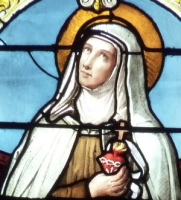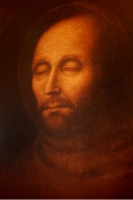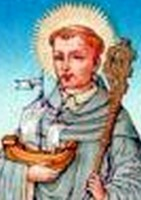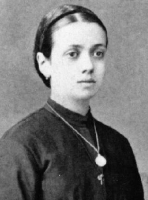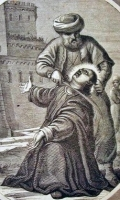St. Apollonius the Apologist
Feastday: April 18
Death: 185
Martyr whose Apologia, or defense of the faith, is considered one of the most priceless documents of the early Church. Apollonius was a Roman senator who was denounced as a Christian by one of his slaves. The Praetorian Prefect, Sextus Tigidius Perennis, arrested him, also putting the slave to death as an informer. Perennis demanded that Apollonius denounce the faith, and when he refused, the case was remanded to the Roman senate. There a debate took place between Perennis and Apollonius that clearly outlines the beauty and the value of Christianity. Despite his eloquent defense, Apollonius was condemned and beheaded.
For 4th-c martyr, see Apollonius of Rome.
Saint Apollonius the Apologist or Saint Apollonius of Rome (died 21 April 185) was a 2nd-century Christian martyr and apologist (not to be confused with Apollinaris Claudius, another contemporary apologist) who was martyred in 185 under the Emperor Commodus (161-192).
Life
Four different sources speak of Saint Apollonius of Rome:
a record of the trial incorporated into the Ecclesiastical History of Eusebius of Caesarea (265-340);
chapters 40 and 42 of the De Viris Illustribus by Saint Jerome (347-420),
two versions of the Passio of Apollonius, one Greek, the other Armenian, which were discovered in the late 19th century.[1][3]
These sources present Apollonius as an illustrious Roman, even, it seems, a senator, and an exceedingly talented man, well versed in philosophy. He was denounced as a Christian to the Pretorian Prefect Perennius. Summoned to defend himself, he read to the senate, according to Saint Jerome, "a remarkable volume" in which, instead of recanting, he defended the Christian faith. As a result, he was condemned to death on the basis of the law established by the Emperor Trajan.[1][3]
The sources say he was subjected to two investigations, the first by the Prefect Perennius, the second, three days later, by a group of senators and jurists. The hearings were conducted in a calm and courteous manner. Apollonius was permitted to speak with only rare interruptions, aimed at getting him to tone down his remarks, which were making him liable to punishment.[1]
Apollonius was not afraid to die, because, he said: "There is waiting for me something better: eternal life, given to the person who has lived well on earth." And he argued for the superiority of Christianity's concepts of death and life.[3]
The sources disagree on the manner of his death. The Greek Passio says he died after having his legs crushed, a punishment inflicted also on the slave who denounced him; but in the Armenian account he is decapitated.[1][3]
Veneration
Apollonius was not mentioned in the earliest Christian martyrologies, not being at first the object of individual commemoration. In the Middle Ages he was confused with two other saints, Apollo of Alexandria and the Apollonius who was martyred with Saint Valentine and whose feast is on 18 April. As a result, this date was attributed also to Saint Apollonius of Rome, even in editions of the Roman Martyrology, the latest editions of which have, however, restored the date of 21 April.[1]
At Rome, commemoration of Saint Apollonius, philosopher and martyr. Under the Emperor Commodus, he defended, before the Prefect Perennius and the Senate, the cause of the Christian faith in a finely argued address, and then, after being condemned to death, confirmed it by the witness of his blood
Saint Athanasia of Aegina
புனித_அத்தனாசியா (790-860)
ஏப்ரல் 18
இவர் (#StAthanasiaOfAegina) அகினா என்ற இடத்தில் பிறந்தார்.
இவர் முதலில் ஒருவரை மணந்தார். அவர் திருமணம் நடந்து, இரண்டு வாரங்களுக்குள்ளாகவே, சரசென்ஸ் என்ற இனத்தவரால் கொல்லப்பட்டவே, இவர் கைம்பெண் ஆனார்.
இதற்குப் பிறகு இவர் வேறொருவரை மணந்தார். அவர் இவரிடம், "நாமிருவரும் இல்லறத்தில் துறவற வாழ்க்கை வாழ்வோம்" என்றார். இவரும் அதற்குச் சரியென்று சொல்லி, ஒரு துறவியைப் போன்று வாழ்ந்து வந்தார். இவரது எடுத்துக்காட்டான வாழ்க்கையைப் பார்த்துவிட்டுப் பலரும் இவரிடம் சீடராகச் சேர்ந்தார்கள்.
இதன் பிறகு இவர் கான்ஸ்டன்டான்டிநோப்பிளுக்குச் சென்று, அங்கிருந்த மன்னருக்கு ஆலோசகராகப் பணியாற்றினார். இவர் கொடுத்த ஆலோசனைகள் மன்னருக்குப் பெரிதும் உதவின.
இவ்வாறு ஒரு துறவியாய், ஆலோசகராய் வாழ்ந்த இவர், 860 ஆம் ஆண்டு இறையடி சேர்ந்தார்.
Profile
Born to the nobility, the daughter of Nikita and Marina, Athanasia grew up in a pious family. She early felt drawn to the religious life; legend says that when she was a young girl learning to weave, a star suddenly appeared, settled over her heart, and she was enlightened. However, at her parent's request, she married at age 16 to an army officer. Widowed after 16 days of marriage when her husband died in battle against invading Arabs. She again considered the religious life, but an imperial edict required all single women of marriage age to marry soldiers.
Her second marriage was to a deeply religious man; the two conducted Bible studies in their homes, and took in the sick and poor. Her husband felt drawn to become a monk, and Athanasia agreed with his new vocation. She became a nun, gave away the bulk of her possessions, converted her home into a convent, obtained a spiritual director named Matthias, had other sisters move in with her, served as abbess, and lived a life of severe austerity. She built three churches. The community later moved to Timia where Athanasia became widely known for miraculous healings. To escape the press of people who were drawn to her reputation of holiness, and return to the quiet, prayerful life, she and two sisters fled in secret to Constantinople where she lived as an anchoress in a cell for seven years; while walled away, she was an advisor to Empress Theodora. Obeying the appeals of her sisters, she returned to Timia very late in life, and spent her last days there.
Many stories have come down to us about Athanasia, most concerning her activities after death. During Mass at the convent, forty days after Athanasia's death, two of her sisters received a vision of Saint Athanasia at the gates of heaven. There, two radiant men placed a crown with crosses on her head, handed her a brilliant staff and led her through the gates to the altar.
Shortly before her death, Athanasia left orders that the poor be fed in her memory for forty days. Her sisters, however, set up a memorial trapeza, a dining hall where religious and pilgrims to gather for food, for only nine days. Athanasia appeared to some of the sisters and said, "It was wrong that you did not fulfill my testament, the forty-day commemoration in church of those who have fallen asleep and the feeding of the poor greatly helps sinful souls, while heavenly mercy is sent down from righteous souls to those who carry out the commemoration." She then jabbed her staff into the ground, and became invisible. The next day, the staff had sprouted and become a living sapling.
A year after Athanasia's death, a possessed woman was brought to her grave. The people with her dug up the earth over the grave, hoping that contact with it would heavel the woman. They smelled a perfume coming from the grave, and removed Athanasia's coffin. When she touched it, the possessed woman was healed. The witnesses opened the coffin, and found Athanasia's body incorrupt, streaming fragrant myrrh.
When these witnesses found the body in this state, they transferred it to a new ark. Her sisters, wanting to clothe the body in silk, removed the hair shirt Athanasia had worn in life and death. However, when they tried to put the silk clothes on her, the body developed severe rigor, hands clasped to the breast, and they could not dress her in the rich dress. The sisters took this as the Athanasia's love of pious poverty. One of the sisters called out to the saint, "O our lady, as thou didst unquestioningly obey us while thou didst live with us, so even now be well pleased to obey us and be clothed in these garments, our humble gift offered unto thee." The body then sat up, extended her hands, and was dressed in the silk clothing.
Born
8th century on the Island of Aegina, Greece
Died
• 14 August 860 at Timia of natural causes
• relics preserved at Timia in a specially made reliquary, and are known for their healing powers
Representation
• young girl weaving with a star over her or on her breast
• with Empress Theodora
Blessed James Oldo
Also known as
• James of Oldo
• James D'Oldo
• James of Lodi
• James Oldi
• Jakob, Jacopo, Giacomo
Profile
The son of Marchese and Fiordonina Oldo, his father died when the boy was young, leaving him a legacy that allowed to grow up a rich and self-indulgent youth. Married to Catharine Bocconi, a woman of similar disposition; father of three children. The death of a friend to disease brought his own mortality to James' attention and matured him slightly. Then one day a travelling reproduction of the Holy Sepulchre came to his home town of Lodi, Italy. As a joke, James lay down on it to compare his height to Christ's. While lying there, he had an almost instantaneous conversion experience.
He became a Franciscan tertiary. James took care of a sick priest who, in return, taught him Latin. His mother and wife were opposed to James's change until his mother had a vision of being before the judgement seat of God. Both women became Franciscan tertiaries and turned their mansion into a center for prayer. They and spent their later years working with the sick and the prisoners taken in the civil war that devastated Lodi.
Upon his wife's death, James became a priest in 1397. His acts of penance became so severe that his bishop had to order him to eat at least three times a week. Preacher whose life and words moved many to enter the religious life. Had the gift of prophecy; predicted wars and his own death.
Born
1364 at Lodi, Italy
Died
• 18 April 1404 of an unknown buried in the church of Saint Julian, the construction of which he and his wife had financed
• when moved seven years after his death, his body was found incorrupt
• re-interred in the nearby Church of Sant'Egidio in 1580
• re-interred in the Cathedral of Lodi in 1789
Beatified
26 March 1934 by Pope Pius XI (cultus confirmed)
Blessed Marie of the Incarnation
Also known as
• Barbara Aurillot
• Barbara Avrillot
• Barbe Acarie
• Barbe Aurillot
• Barbe Avrillot
• Madame Acarie
• Marie Acarie
• Mary of the Incarnation
Profile
Daughter of a French government official named Nicholas Aurillot. Educated at her aunt's convent at Longchamps. Though attracted to religious life, she married Pierre Acarie, an aristocrat and treasury official, at age 16. Mother of six, three of whom became Carmelites, and one a priest.
Peter supported the Catholic League against Henry IV. When Henry became king he seized the Acarie estates, impoverished the family, and exiled them from Paris, France. Barbara went to court over the matter, won, and reclaimed part of the family fortune.
She was devoted to the writings of Saint Teresa of Avila, and became active in charities. Her good works eventually won her the admiration and support of King Henry. Brought the Discalced Carmelites of Saint Teresa to France, founding five houses between 1604 and 1609.
Widowed at 47. Carmelite lay sister in 1613 at Amiens, France, taking the name Mary of the Incarnation. Spiritual student of Saint Francis de Sales. Known for receiving visions and ecstasies, and for supernatural gifts.
Born
1 February 1566 at Paris, France as Barbe Aurillot
Died
18 April 1618 at Pontoise, France of natural causes
Beatified
5 June 1791 by Pope Pius VI
Patronage
• against impoverishment
• against loss of parents
• against poverty
• parents separated from children
• poor people
• widows
Blessed Andrés Hibernón Real
அருளாளர்: ஆண்ட்ரேஸ் ஹிபெர்நான் ரியல்
மறைப்பணியாளர் :
பிறப்பு : கி.பி. 1534
மூர்சியா, ஸ்பெயின் அரசு
இறப்பு : ஏப்ரல் 18, 1602 (வயது 68)
காண்டியா, வலென்சியா, ஸ்பெயின் அரசு
ஏற்கும் சமயம் :
ரோமன் கத்தோலிக்க திருச்சபை (Roman Catholic Church)
முக்திபேறு பட்டம் : மே 22, 1791
திருத்தந்தை ஆறாம் பயஸ் (Pope Pius VI)
பாதுகாவல் :
மூர்சியா (Murcia)
அல்கன்டரில்லா (Alcantarilla)
அருளாளர்: ஆண்ட்ரேஸ் ஹிபெர்நான் ரியல், "பிரான்சிஸ்கன் இளம் துறவியர் சபையைச்" (Order of Friars Minor) சேர்ந்த ஒரு ஸ்பேனிஷ் ரோமன் கத்தோலிக்க மறைப்பணியாளர் ஆவார்.
அந்நாளைய ஸ்பேனிஷ் அரசின் மூர்சியா நகரில் 1534ம் ஆண்டு வசதியான பிரபுத்துவ குடும்பத்தில் பிறந்தவர் ஹிபெர்நான். பாதகமான சூழ்நிலைகளின் காரணமாக, இவரது மொத்த குடும்பமும் நிதி நிலைமையில் நொடித்துப்போனது. இவர்களது குடும்பச் சுமையை குறைக்கும் நோக்கில், இவரது மாமன் ஒருவர் இவரது கல்விப் பொறுப்பினை ஏற்றுக்கொண்டார். எனவே இவர் தமது கல்வியை வலேன்சியா (Valencia) நகரில் தொடங்கினார். இவரது இன்னொரு மாமன் ஒருவர் பாதிரியாராக இருந்த மூர்சியா பேராலயத்தில் இவர் திருமுழுக்கு பெற்றார்.
இவர் தமது இளமையில், கஷ்டப்படும் தமது பெற்றோருக்கும் சகோதரர்களுக்கும் உதவும் பொருட்டும், எதிர்பாராத விதமாக வரவிருக்கும் சகோதரியின் திருமணத்திற்காகவும் வெளியூர் சென்று கடினமாக உழைத்து கணிசமாக பொருள் சேர்த்தார். தாம் உழைத்துச் சேர்த்த பணத்துடன் ஊர் திரும்பும் வழியில், இவரை வழிமறித்த திருடர்கள் கும்பல் ஒன்று, இவரிடமிருந்த பணம் பொருள் முழுவதையும் கொள்ளையடித்துச் சென்றது. இதனால் தாம் அடைந்த ஏமாற்றமும் வருத்தமும், தம்மை இவ்வுலகின் பொருள் ஆசைகளில் எவ்வளவு தூரம் ஈர்த்திருக்கிறது என்பதனை உணர்ந்தார்.
திருட்டு போகக்கூடிய - அழிந்து போகும் இவ்வுலக செல்வங்களை சேர்க்கும் ஆசைகளுக்கு மாறாக, இனிமேல் யாராலும் கொள்ளையடிக்க இயலாத செல்வங்களை சேர்க்க முடிவு செய்தார்.
1556ம் ஆண்டு, ஸ்பெயின் நாட்டின் தென்கிழக்கு பிராந்தியமான "அல்பாசிட்" (Albacete) என்னுமிடத்திலுள்ள "இளம் துறவியர் சபையின்" பள்ளியில் (Convent of the Order of Friars Minor) சேர மிகவும் தாழ்ச்சியுடன் கெஞ்சி அனுமதி பெற்றார். 1557ம் ஆண்டு, நவம்பர் மாதம், முதல் தேதியன்று, தமது துறவு ஆடைகளைப் பெற்றுக்கொண்டதுடன், அன்றுமுதல் தமது புதுமுக துறவுப் பயிற்சியையும் தொடங்கினார்.
அடிக்கடி அன்னை மரியாளின் திருத்தலங்களை நாடிச் செல்ல ஆரம்பித்த ஹிபெர்நான், மணிக்கணக்கில் நற்கருணையாண்டவரின் முன்பு முழங்கால்படியிட்டு நின்றபடி செபிக்க தொடங்கினார். இதன்மூலம் அவர் நற்கருணையாண்டவரிடம் தீவிர பக்தியை தம்மில் உருவாக்கினார். இந்த துறவி, அடிக்கடி தமது குருக்களுடன் இணைந்து நோயிற்றோரை சந்திக்க சென்றார்.
1563ம் ஆண்டு ஃபெப்ரவரி மாதம், இவர் "எல்ச்" (Elche) என்னுமிடத்திலுள்ள "புனித ஜோஸ் 'அல்கன்டரைன்' ஃபிரான்சிஸ்கன் சீர்திருத்த பள்ளிக்கு" (Alcantarine Franciscan Reform Convent of San José) மாற்றப்பட்டார்.
1574ம் ஆண்டுவரை அங்கேயே தமது செப வாழ்வினை அர்ப்பணித்த துறவி ஹிபெர்நான், "வலேன்சியாவில்" (Valencia) ஸ்தாபிக்கப்பட்டிருந்த பள்ளியின் நடைமுறைப் பணிகளை பெற்றுக்கொள்வதற்காக தமது துறவு மட தலைவர்களால் "வலேன்சியா" (Valencia) அனுப்பப்பட்டார். அங்கே, இவருக்கு "வலென்சியா" உயர்மறைமாவட்ட பேராயர் புனிதர் "ஜுவான் டி ரிபெர்" (Archbishop of Valencia Saint Juan de Riber) அவர்களின் நட்பு கிட்டியது.
தாம் மரிப்பதன் நான்கு ஆண்டுகளின் முன்னேயே தாம் மரிக்கப்போகும் நாளை முன்னறிவித்த இத்துறவி, அவர் முன்னறிவித்திருந்ததன்படியே, 1602ம் ஆண்டு, ஏப்ரல் மாதம் 18ம் நாள் செபமாலை செபித்துவிட்டு மரித்தார்.
Profile
Born to an impoverished Spanish noble family. Educated by his uncle who was a chaplain in the cathedral of Murcia, Spain. Andrés worked and saved for several years to build up funds to provide for his sister’s marriage and help support his parents; while taking it to them he was attacked by thieves who took it all. He took this as a sign from God that worldly riches had no value, and vowed to devote himself to spiritual riches. He joined the Franciscan Friars Minor in Albacete, Spain on 1 November 1557. He made short pilgrimages to Marian shrines, visited the sick with priests, and spent endless hours in meditation and prayer during Eucharistic Adoration. He moved to the Alcantarine reform convent of San José in Elche, Spain in February 1563; in 1564 he was there when Saint Paschal Baylon received the habit. Assigned to establish a convent in Valencia, Spain, he became a close friend of Saint Juan de Ribera.
Born
1534 in Murcia, Spain
Died
• predicted the date of his death four years before the fact
• 18 April 1602 in Gandia, Valencia, Spain of natural causes immediately after having prayed a rosary
• some relics enshrined in Gandia until they were moved in 1936 to prevent them being destroyed by anti–Catholic forces in the Spanish Civil War
• some relics enshrined in the cathedral in Murcia, Spain
• some relics enshrined in Alcantarilla, Spain in 1936
Beatified
22 May 1791 by Pope Pius VI at Saint Peter’s Basilica, Rome, Papal States (modern Italy) (cultus confirmation)
Patronage
• Alcantarilla, Spain (chosen in May 1950)
• Murcia, Spain
Blessed Idesbald of Dunes
Profile
Court page and courtier to the Count of Flanders, Belgium. Canon priest of Veurne, Belgium in 1135, a position he resigned to become a Cistercian monk at the abbey of Our Lady of the Dunes on the sand hills between Dunkirk and Nieuport. Abbot there for 12 years.
Born
c.1095 at Flanders, Belgium
Died
• 1167
• remains relocated in 1577 to avoid raiders who looted the abbey
• remains relocated in 1623; they were found to be incorrupt
• relics relocated to Bruges, Belgium in 1796 to avoid them being destroyed in the French Revolution
• relics relocated to a chapel at Our Lady of the Potteries Abbey in 1830
• skeletal left arm in the Diocese of Bruges, Belgium
• skeletal right thigh enshrined in the church of Notre-Dame of the Dunes Abbey on 23 June 1968
Beatified
23 July 1894 by Pope Leo XIII (cultus confirmed)
Representation
monk holding a abbot's staff and a ship
Patronage
• against fever
• against rheumatism
• against gout
• sailors
• shrimp fishers
• polder farmers
• Flemnish nobility
• Sint-Idesbald, Belgium
Blessed Savina Petrilli
Also known as
Sabrina
Profile
Second daughter of Celso and Matilde Venturini. At age 10 she read a life of Saint Catherine of Siena, and immediately developed a devotion to her. Savina made her First Communion at age 12. Joined the Congregation of the Daughters of Mary at age 15 and was in was chosen president of the Congregation in 1873. In 1869 she had an audience with Pope Pius IX who urged her to walk in the footsteps of Saint Catherine of Siena. On 15 August 1873 she and five companions, in the chapel of her family’s home, took vows of chastity, poverty and obedience in order to found the Sisters of the Poor of Saint Catherine of Siena whose mission is to care for homeless and poor young people. The Sisters founded their first house in Onano, Viterbo, Italy in 1881, their first foreign mission in Belem, Brazil in 1903, and received final approval on 17 June 1906 by Pope Pius X. The Congregation continues her good work today in Italy, Brazil, Argentina, India, Philippines, Paraguay and the United States with over 80 houses and more than 500 sisters.
Born
29 August 1851 in Siena, Italy
Died
5:20pm on 18 April 1923 in Siena, Italy of cancer
Beatified
24 April 1988 by Pope John Paul II at Saint Peter’s Square, Rome, Italy
Saint Eleutherius of Illyria
Also known as
Eleftherios, Eleuterio, Eleuterus, Eleutherus, Liberalis, Liberator, Liberatore
Profile
Son of Saint Anthia of Illyria; his father died when the boy was very young. Educated by Bishop Dynamius. Bishop of Illyria, Dalmatia (in modern Croatia) at age 20. Arrested for bringing an imperial Roman official to Christianity. Martyred in the persecutions of Hadrian along with his mother and eleven other Christians whose names have not come down to us.
Born
c.100, possibly in or near Messina, Italy
Died
• beaten to death c.138
• relics enshrined in Rieti, Troia and Velletri in Italy
Patronage
• diocese of Ariano Irpino-Lacedonia, Italy
• Civitacampomarano, Italy
Blessed Luca Passi
Profile
Born to the Venetian nobility. Ordained on 13 March 1813. Priest in the archdiocese of Venice, Italy. Founded the Institute of the Teaching Sisters of Saint Dorothy. Founded the Pious Society of Saint Dorothy.
Born
22 January 1789 in Bergamo, Italy
Died
• 18 April 1866 in Venice, Italy of natural causes
• buried at the mother house of the Institute of the Teaching Sisters of Saint Dorothy in Venice, Italy of natural causes
Beatified
• 13 April 2013 by Pope Francis
• beatification celebrated at the Basilica of San Marco, Venice, Italy, presided by Cardinal Angelo Amato
Blessed Roman Archutowski
Additional Memorial
12 June as one of the 108 Martyrs of World War II
Profile
Priest in the archdiocese of Warsaw, Poland. Exceptional teacher and rector of the seminary in Warsaw. Imprisoned and tortured at the Majdanek concentration camp by the Gestapo during the Nazi occupation of Poland in World War II. Martyr.
Born
5 August 1882 in Karolin, Mazowieckie, Poland
Died
Palm Sunday, 18 April 1943 in Majdanek, Lubelskie, Poland from starvation and disease
Beatified
13 June 1999 by Pope John Paul II
Saint Perfecto of Córdoba
Also known as
Perfectus
Profile
Priest. Accosted on the street one day by Moors who asked his opinion of Jesus and Mohammed, promising no harm to him no matter the answer. Perfecto explained the Jesus was the Son of God and our Savior, while Mohammed was a false prophet. When his questioners felt that enough time had passed that their promise has dissipated, they had Perfecto arrested, tried, and executed by a Muslim court for blasphemy. Martyr.
Born
at Córdoba, Spain
Died
850 at Cordova, Spain
Saint Galdinus of Milan
Also known as
• Galdinus della Sala
• Galdimus, Galdin, Galdino
Profile
Milanese noble. Priest. Chancellor. Archdeacon. Supported the Roman Pope during the schism of 1159. Fled Milan, Italy in 1161 when Frederick Barbarossa besieged the city in support of the anti-pope, yet was still elected bishop. Cardinal in 1165. Archbishop in 1166. Papal legate to Lombardy. Returned to Milan after the war and helped rebuild it. Died in the pulpit immediately following a sermon against heresies.
Born
1100 at Milan, Italy
Died
1176 at Milan, Italy of natural causes
Saint Laserian of Leighlin
Also known as
• Laserian mac Nadfraech
• Laisren, Lamliss, Lasreano, Lasserian, Molaise, Molaisre, Molaisse, Molios
Additional Memorial
6 January as one of the Twelve Apostles of Ireland
Profile
Son of Cairel. Student of Saint Murin of Fahan. Hermit on Holy Island, Lamlach bay. Ordained by Pope Saint Gregory the Great in Rome, Italy. Consecrated bishop by Pope Honorius I. Apostolic Legate to settle the question of the Easter observance.
Died
7th century of natural causes
Patronage
diocese of Leighlin, Ireland
Saint Agia of Hainault
Also known as
• Agia of Mons
• Aia, Austregildis, Aya, Aye
Profile
Wife of Saint Hidulphus of Hainault. They separated to enter religious life, Agia becoming a Benedictine nun at the abbey at Mons, Belgium. Widow. Legend says that she managed to avert an injustice by speaking from the tomb.
Died
c.711 of natural causes
Patronage
lawsuits
Blessed Joseph Moreau
Additional Memorial
2 January as one of the Martyrs of Anjou
Profile
Priest of the diocese of Angers, France. Martyred in the persecutions of the French Revolution.
Born
21 October 1763 in Saint-Laurent-de-la-Plaine, Maine-et-Loire, France
Died
guillotined on Good Friday, 18 April 1794 at Angers, Maine-et-Loire, France
Beatified
19 February 1984 by Pope John Paul II at Rome, Italy
Saint Ursmar of Lobbes
Also known as
Ursmaro
Profile
Abbot of the Benedictine abbey at Lobbes, Belgium c.689. Trained Saint Dodo. Missionary bishop. Helped found Aulne Abbey and the Abbey of Wallers-en-Faigne, France.
Born
c.640
Died
713 in Lobbes, Belgium of natural causes
Patronage
Lobbes, Belgium
Saint Calocerus of Brescia
Also known as
Calogerus
Profile
Officer in the army of Emperor Hadrian. Convert. Martyr. Connected in old writings with Saint Faustinus and Saint Jovita.
Died
• beheaded in 2nd century Albenga, Italy
• relics in Chiavaz, Italy
Blessed Louis Leroy
Profile
Member of the Missionary Oblates of Mary Immaculate. Priest. Martyr.
Born
8 October 1923 in Ducey, Manche, France
Died
18 April 1961 in Ban Pha, Xieng Khouang, Laos
Beatified
• 11 December 2016 by Pope Francis
• beatification recognition celebrated in Vientiane, Laos, presided by Cardinal Angelo Amato
Saint Eugene of Raith-Sithe
Also known as
Eoghan
Profile
Bishop of Raith-Sithe (Ráth Sí Rashee), Down, Ireland.
Born
latter 6th century Ireland
Died
618–619 in Ireland of natural causes
Saint Wicterp of Augsburg
Also known
Wigbert, Wiho, Wicho
Profile
Abbot at Ellwangen, Germany. Founded monasteries at Füssen, Wessobrunn and Kempten in Germany. Bishop of Augsburg, Germany.
Died
749 of natural causes
Saint Anthia of Illyria
Profile
Mother of Saint Eleutherius of Illyria. Martyred in the persecutions of Hadrian along with his mother and eleven other Christians whose names have not come down to us.
Died
c.138
Saint Elpidius of Melitene
Also known as
Elpidio
Profile
Martyr.
Born
4th century Armenian
Died
at Melitene, Armenian
Saint Corebus
Profile
Imperial Roman prefect of Messina, Sicily. Converted to Christianity by Saint Eleutherius. Martyred in the persecutions of Emperor Hadrian.
Died
c.138
Saint Gebuinus of Lyons
Profile
Archbishop of Lyons, France.
Died
1080 of natural causes
Patronage
cathedral chapter of Langres
Saint Hermogenes of Melitene
Profile
Martyr.
Born
4th century Armenian
Died
at Melitene, Armenian
Saint Eusebius of Fano
Profile
Bishop of Fano, Italy.
Died
in 526 in prison at Ravenna, Italy
Saint Pusicio
Profile
Courtier to Shapur II of Persia. Martyr.
Died
stabbed through the neck in Persia (modern Iran)
Saint Bitheus
Profile
Sixth-century monk in Wales. Travelled with and helped Saint Finian of Clonard in his work in Ireland.
Saint Genocus
Profile
Sixth-century monk in Wales. Travelled with and helped Saint Finian of Clonard in his work in Ireland.
Saint Cogitosus
Profile
Eighth-century monk at Kildare, Ireland. Wrote a biography of Saint Brigid.
Also celebrated but no entry yet
• Antusa of Constantinople
• Giovanni Isauro
• Lassair of Donaghmoyne



